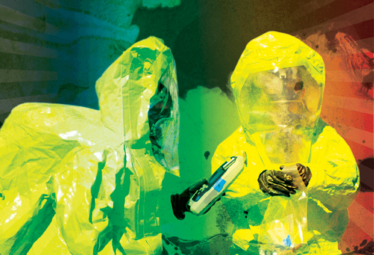Spectroscopy brought down to size
New developments are mobilizing Raman, mid-infrared and near-infrared spectroscopy for a whole host of innovative handheld applications.
Heinz Siesler |

Since the early 1970s, I have been active in vibrational spectroscopy. And, for the last decade, I have made a point of following the continual development of miniaturized spectrometers for Raman, mid-infrared (mid-IR) and near-infrared spectroscopy (NIR). Forty years ago, Raman and Fourier transform infrared (FT-IR) spectrometers were huge, room-filling machines, and NIR spectrometers were just about to evolve from add-ons to ultraviolet-visible (UV-VIS) or IR spectrometers and appear as standalone instruments. Things began to change over the next four decades, with many exciting hardware and software developments for vibrational spectroscopy appearing. Nevertheless, apart from the introduction of light-fiber optics, special probes and chemometric evaluation routines enabling the technology to move out of the lab to the process, the techniques were still strictly for scientists. In contrast, the development of miniaturized, handheld instruments would not only lead to a further extension of the range of applications but also suggested that these instruments would eventually appear in non-traditional user environments.
Indeed, when handheld Raman and mid-IR spectrometers first appeared, the military adopted them much more quickly than industry for on-site chemical quality and process control in homeland security and antiterrorism applications. Since then, other important public services, such as fire and rescue services, environmental agencies, food control institutions, and law enforcement organizations, have also recognized the potential for handheld spectrometers.
In the majority of the above applications, the primary objective is rapid and safe on-site identification of unknown – often hazardous or toxic – materials or for authenticating the correct origin of goods by trained users – but not necessarily scientists. However, I think that the educational and conference activities planned for the 2015 “International Year of Light and Light-based Technologies” (www.light2015.org) will certainly help share the message that vibrational spectroscopy can significantly contribute towards improving safety and general standards in all areas of our lives.
Miniaturize technology; don’t minimize performance
When miniaturizing an analytical instrument, one of the key objectives is to ensure that the reduction in size does not compromise measurement performance and precision. It therefore follows that handheld vibrational spectrometers will only have a real impact on quality and process control if the spectra obtained from them are comparable to those produced by larger bench-top instruments. However, numerous recent investigations (which included comparing miniaturized with conventional spectrometers for solving the same analytical problems) have shown that reliable and accurate results for qualitative as well as quantitative applications are achievable with handheld instruments (1–3).
New developments are driven chiefly by the potential and advantages of micro-electro-mechanical systems (MEMS) production for building extremely miniaturized devices that can perform optical-mechanical functions. Handheld Raman systems are based generally on dispersive technology with 785-nm excitation, but recently 1064-nm excitation systems have been introduced for more efficient fluorescence suppression. Some instruments have orbital raster scan (ORS) technology for interrogating a larger sample area without loss of spectral resolution. Handheld mid-IR instruments are limited to attenuated total reflection (ATR) measurements and are offered as FT-IR systems or with a linear variable filter (LVF) monochromator. NIR spectrometers can operate in the diffuse-reflection, transmission or transflection mode and their enabling technology varies between dispersive and LVF or digital light processing (DLP) using digital mirror devices (DMD).
In general, handheld instruments come with measurement software and the manufacturers frequently offer additional software packages for qualitative and quantitative evaluation of the spectra. For most instruments, you can buy libraries for specific material classes (drugs, explosives, polymers) for fast and efficient identification. They do vary in weight, from approximately 1 kg down to 60 g for an ultra-compact system.
Testing times
For many years at the University of Duisburg-Essen, we have been testing various handheld Raman, mid-IR and NIR spectrometers for a broad range of interesting applications. During testing, we’ve had to revise our perception of the practical use of vibrational spectroscopy completely. We have discovered a number of interesting applications. Here’s a small sample:
We found that polymers and other additives present in bitumen could readily be determined quantitatively by on-site/on-the-road measurements. Taking into account the tremendous costs involved in road construction and, specifically, the importance of using the correct additive formula for improving the adhesive and rheological properties of bitumen, the impact of such measurements for road surface quality – and hence the safety of motorists – is clearly beneficial.
In a feasibility study for a global mining company, we verified the possibility of quantifying milled rock samples for relevant minerals. For mine exploration studies, a fast on-site evaluation of geological test samples is essential and handheld instrumentation will certainly play a dominant role in such investigations in the near future.
To address increasing public concern over fraud and deception in seafood marketing, we developed a fast and reliable analytical procedure for authenticating fish (4). Similar fish of superior/lower quality and higher/lower prices are difficult to distinguish by visual inspection. Instead, we used handheld NIR diffuse reflection spectroscopy and evaluated the spectral data using principal component analysis (PCA) and classified them by soft independent modeling of class analogies (SIMCA). Using this procedure, test fish could be identified unambiguously and assigned to the correct species.
Clearly, these miniature handheld spectrometers are enabling a new population of users in new measurement environments to gain important benefits. In addition, I can foresee the use of such instruments beyond police forces, food inspection agents or military personnel. Just as mobile phones have become essential in every-day-life (irrespective of gender and social or financial status of the users), so why shouldn’t a user-friendly handheld spectrometer of similar technical complexity, equipped with evaluation software, gain the same public pervasiveness? Black market goods like bastard amber, fake ivory and silk shirts could be consigned to the past, together with the issues we now have with food quality, adulteration and authentication, as well as healthcare technology.
Despite these bright future prospects, let me end with some words of caution. If I’ve sparked your interest in handheld instruments and you’ve decided to investigate them further, be sure to critically scrutinize the technical background of new, elaborately advertised products – particularly those offering investment opportunities and life-science applications – because many of these, in my opinion, appear to lack feasibility.
Heinz Siesler is an Emeritus Professor in the Department of Physical Chemistry at the University of Duisburg-Essen, Essen, Germany.
Spec Snapshot I: Authenticating the Authentic

Neville Broad, Managing Director, Authenticate Ltd, Sittingbourne, Kent.
Experience:
I have been using handheld analytical instruments for seven years, starting with Raman.
I routinely use handheld Fourier transform infrared (FTIR), NIR, Raman and X-ray fluorescence (XRF) spectrometry because they provide a minimal footprint and can be used in the field as well as in the laboratory.
My company, Authenticate Limited (www.nwbspectroscopy.co.uk) assesses suspect counterfeit pharmaceuticals and luxury goods. The technologies listed above are all part of a toolbox of chemical identification options, for rapid, often non-destructive sample assessment.
Opinion:
Handheld instrument performance is definitely good enough for qualitative assessment of suspect goods. Quantification is possible but less utilized. I would say in general, handhelds are not quite as good as benchtop instruments; however, their resolution and performance are sufficient to provide cost-effective results. In reality, they are complementary tools and not intended to replace superior technology, or more specific analytical techniques, such as mass spectrometry for the confirmation of unknowns.
Spec Snapshot II: Bringing Home the Harvest

Christian Huck, Professor, Institute of Analytical Chemistry and Radiochemistry, CCB-Center for Chemistry and Biomedicine, Leopold-Franzens University, Innsbruck, Austria.
Experience:
Our research group has been using handheld NIR devices since 2011.
Objectives:
One of our current projects aims to determine the optimum harvest time of medicinal plant materials using handheld NIR instrumentation.
Opinion:
- Top three benefits (compared with benchtop instruments):
- Easier to handle; often they are small enough to carry in a pocket
- Easy data transfer via Wifi or Bluetooth
- Extremely attractive for taking measurements “in the field”
Spec Snapshot III: Process Monitoring in Hand

Manel Alcalà Bernàrdez, Associate Professor, Applied Chemometrics Research Group, Faculty of Sciences, Universitat Autònoma de Barcelona (Autonomous University of Barcelona), Spain.
Experience:
My research group studies applied chemometrics for the pharmaceutical and chemical industry and we have been using benchtop instruments for many years. Our development and validation of analytical methods using benchtop spectrometers focuses on installing the technology in QC/QA facilities, where the environmental conditions are suitable for such instruments. However, over the last decade – with the growth in process analytical technology (PAT) applications – the need for small, rugged technology for in-process monitoring is increasing.
Our first experience with handheld spectrometers followed the International Conference on Near Infrared Spectroscopy 2011 (Cape Town, South Africa), when JDSU and I began to collaborate on developing the “MicroNIR” spectrometer. We contributed to spectral acquisition configuration, specifically during the development of a spectral library for identifying pharmaceutical raw materials, and to developing and validating multivariate calibration models for quantitation of active principle ingredients in a pharmaceutical formulation. Our experience with this technology contributed to a feasibility study that demonstrated the performance of the instrument in a real world scenario.
Opinion:
Handheld instrumentation is a good choice for both qualitative and quantitative applications, where technical limitations do not allow the use of traditional benchtop spectrometers. The major benefits are clear: their size, portability, internal power supply and the ability to transmit data wirelessly.
The biggest challenge is to achieve accuracy, repeatability and robustness of spectral response compared with the validation guidelines. This is important; because of the miniaturization and highly integrated setup, the optimization of each part of the spectrometer is highly specific.
I wouldn’t define handheld spectroscopy to be better or worse than traditional benchtop approaches. It is most definitely a complementary technology that provides very specific solutions that are difficult to achieve using traditional instruments.
- D. Sorak et al., “New Developments and Applications of Handheld Raman, Mid-Infrared, and Near-Infrared Spectrometers”, Applied Spectroscopy Reviews, 47(2), 83-115 (2012).
- P. A. Mosier-Boss and M. D. Putnam, “The Evaluation of Two Commercially Available Portable Raman Systems”, Anal. Chem. Insights, 8, 83-97 (2013).
- M. Alcalà et al., “Qualitative and Quantitative Pharmaceutical Analysis with a Novel Handheld Miniature Near-Infrared Spectrometer”, J. Near-Infrared Spectrosc. 21, 445–457 (2013).
- N. O’Brien et al., “Near-Infrared Spectroscopic Authentication of Seafood”, J. Near-Infrared Spectrosc. 21, 299–305 (2013).
Heinz Siesler is an Emeritus Professor of Physical Chemistry at the University of Duisburg-Essen, Germany, with main research interests in the application of vibrational spectroscopy (Raman, mid-IR and NIR) to chemical and polymer research, analysis and quality/process control. He has extensive industrial experience in molecular spectroscopy and thermal analysis gained while working in R&D for Bayer AG, Germany. He also lectured at the University of the Witwatersrand, Johannesburg, South Africa, and worked as a post-doc at the University of Cologne, Germany, after receiving his PhD in Chemistry from the University of Vienna, Austria, in 1970. Heinz continues to supervise PhD students, host guest professors and work as a consultant and a short-course teacher in instrumentation for vibrational spectroscopy, materials science and process control.

















